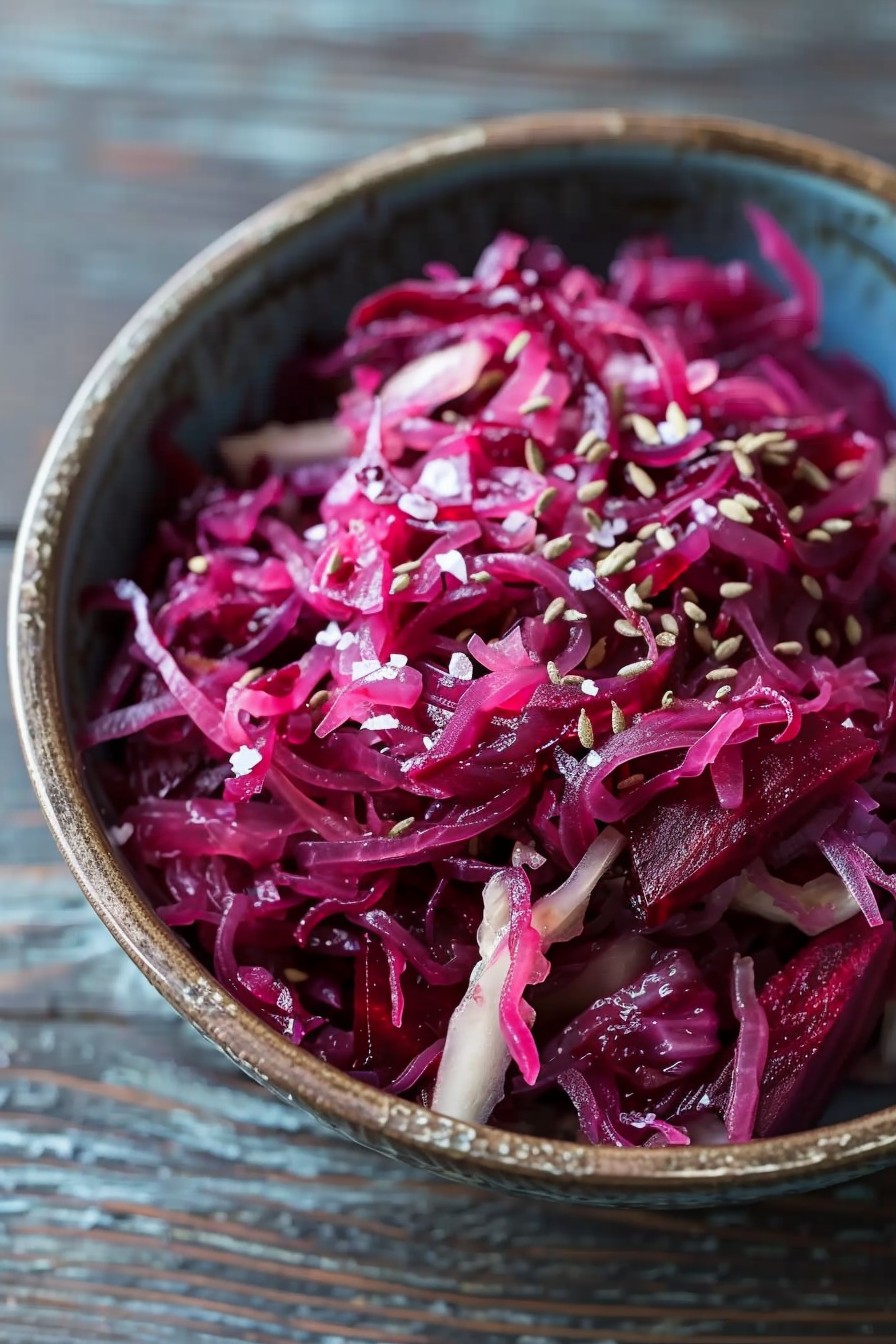Our beet sauerkraut recipe is not just a feast for your taste buds but also a visual delight. Combining the earthy sweetness of beets with the tangy crunch of traditional sauerkraut, this recipe is a must-try for fermenting enthusiasts and foodies alike.
Why This Recipe Works
- The natural sugars in beets add a subtle sweetness that balances the tanginess of the sauerkraut, creating a complex flavor profile.
- Fermentation not only preserves the nutrients in the beets and cabbage but also enhances their probiotic content, making this dish as healthy as it is delicious.
- This recipe is incredibly versatile, serving as a perfect side dish, salad topper, or even a vibrant addition to sandwiches and wraps.
Ingredients
- 1 medium beet, peeled and grated (about 1 cup)
- 1 small head of cabbage, thinly sliced (about 6 cups)
- 1 tbsp sea salt
- 1 tsp caraway seeds (optional)
Equipment Needed
- Large mixing bowl
- Fermentation jar or crock
- Weight (to keep the vegetables submerged)
- Clean cloth or lid (to cover the jar)
Instructions

Step 1: Prepare the Vegetables
Start by peeling and grating the beet into a large mixing bowl. Add the thinly sliced cabbage to the bowl. The combination of these two vegetables not only adds a beautiful color but also a unique flavor profile to your sauerkraut.
Step 2: Add Salt and Seasonings
Sprinkle the sea salt and caraway seeds over the vegetables. The salt is crucial for drawing out the water from the vegetables, which will create the brine necessary for fermentation.
Step 3: Massage the Vegetables
Using your hands, massage the salt into the vegetables for about 5-10 minutes. You’ll notice the vegetables start to release their liquid and become more pliable. This step is essential for ensuring enough brine is produced for fermentation.
Step 4: Pack the Jar
Transfer the vegetable mixture into your fermentation jar, pressing down firmly to eliminate any air pockets. Ensure the vegetables are fully submerged under the brine. If necessary, add a little water to cover.
Step 5: Ferment
Cover the jar with a clean cloth or lid and let it ferment at room temperature (around 68-72°F) for 1-2 weeks. Check daily to ensure the vegetables remain submerged and to release any built-up gases.
Tips and Tricks
For those new to fermenting, here are some advanced tips to ensure your beet sauerkraut turns out perfectly every time. First, the temperature of your fermentation environment can significantly affect the taste and speed of fermentation. A cooler temperature will slow down the process, resulting in a more nuanced flavor. Second, using a weight to keep the vegetables submerged is crucial to prevent mold. Lastly, tasting your sauerkraut throughout the fermentation process allows you to stop the fermentation once it reaches your preferred level of tanginess.
Recipe Variations
- Add grated ginger or garlic for an extra kick of flavor.
- Experiment with different types of cabbage, such as red cabbage, for a variation in color and taste.
- Include other root vegetables like carrots or turnips for added texture and flavor complexity.
Frequently Asked Questions
How do I know if my sauerkraut has gone bad?
If your sauerkraut develops an off smell, mold on the surface, or a slimy texture, it’s best to discard it. Properly fermented sauerkraut should have a tangy smell and a crisp texture.
Can I use table salt instead of sea salt?
While you can use table salt, it’s not recommended because it often contains additives that can affect the fermentation process and the taste of your sauerkraut. Sea salt or kosher salt are better choices.
How long can I store my beet sauerkraut?
Once fermented to your liking, you can store your sauerkraut in the refrigerator for up to 6 months. The cold temperature slows down the fermentation process, preserving the flavor and texture.
Summary
This beet sauerkraut recipe is a colorful, nutritious, and delicious twist on traditional sauerkraut. With its unique flavor profile and health benefits, it’s a fantastic addition to any meal. Happy fermenting!